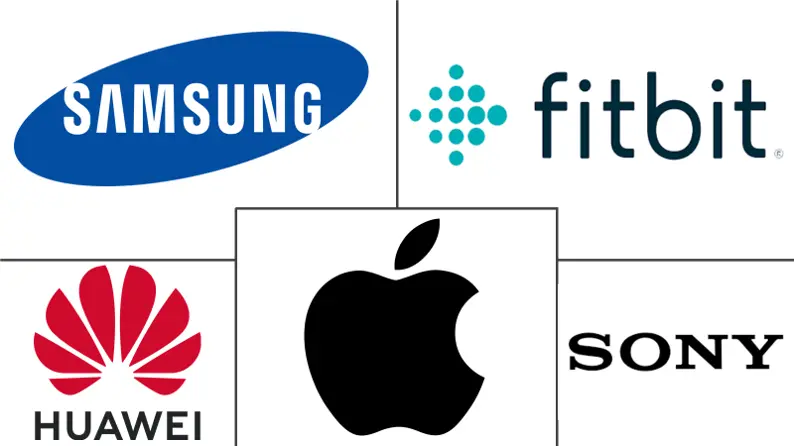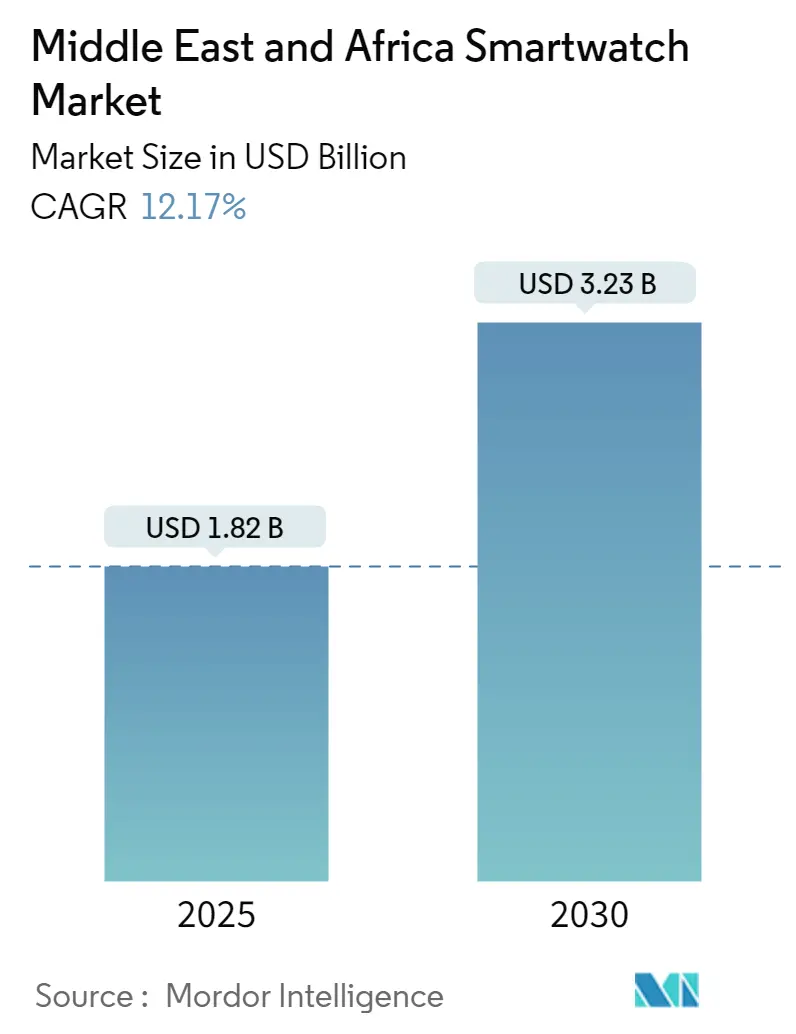
Middle East and Africa Smartwatch Market Analysis by Mordor Intelligence
The Middle East and Africa Smartwatch Market size is estimated at USD 1.82 billion in 2025, and is expected to reach USD 3.23 billion by 2030, at a CAGR of 12.17% during the forecast period (2025-2030).
Owing to the rising penetration rates of urbanization, the demand for aesthetically appealing advanced products that can better serve the consumers' requirements, such as time schedules and multiple features in one device, has been driving the demand for smartwatches.
- Moreover, the enormous millennial population in the region has been adopting smartwatches due to the increased spending for their regular work hours tracking and luxury standards.
- With the number of connected wearable devices in the Middle East & Africa expected to reach 46 million by this year (according to Cisco), the region's wearables market is in the midst of a significant transformation. The market is witnessing a transition from fitness bands to smart wearables like watches.
- South Africa is expected to be the next big market for smartwatches. The adoption level of wearable technology needs to improve in South African households. However, this will likely increase as the technology becomes more widespread and affordable. According to Samsung Enterprise Mobility, smartwatches and other wearables may soon move from consumer devices to valuable enterprise tools. South African CIOs are preparing to manage and secure the wave of new enterprise technologies. They are anticipated to provide massive opportunities for vendors in the forecast period.
- Moreover, the senior population suffering from numerous diseases is creating a shift in-home care toward a more precision-based personal care model. For instance, the Middle Eastern population is aging rapidly. As aging is one of the primary risk factors for cancer, the incidence and prevalence of that disease are growing among all the people in the region. According to the UN figures, it is predicted that the MENA population will increase from 443 million to 654 million by 2050. It is expected that almost 18 million people over the age of 60 will live in the GCC by 2050, representing 25% of the total population and a significant increase in the current number.
- The region's aging population may require constant monitoring, thus, driving the demand for new smartwatches for health tracking purposes during the forecast period. The region is witnessing demand for smartwatches for healthcare purposes. Numerous new use cases are gaining traction, and users are increasingly able to see the health and fitness benefits that wearables can provide.
- The recent outbreak of COVID-19 across the region has affected various significant industries. The shutdowns of production plants have greatly affected the electronics industry. However, sales of wearables are expected to improve with a greater adoption rate in the post-COVID-19 period.
Middle East and Africa Smartwatch Market Trends and Insights
The rise in initiatives for monitoring the health concerns of older people
- The aging population and long-term chronic medical conditions are among the key factors positively influencing the market's growth in the region, along with the rising need for remote patient monitoring solutions. Hospital executives are under constant pressure to cut expenses while maintaining a high standard of patient care. Hospitals use wireless technologies in this setting to run more smoothly, facilitate patient care, and enhance patient experiences.
- The market is witnessing various mergers, acquisitions, and investments by key players and the government as part of their crucial strategy to improve business and their presence to reach customers and meet their requirements for various applications. The rise in such initiatives will create immense growth opportunities for the market to grow and expand throughout the forecast period.
- For instance, in October this year, to accelerate digital transformation and deliver advanced, comprehensive health services, the Ministry of Health and Prevention (MoHAP) signed a Memorandum of Understanding (MoU) with Injazat, the UAE's domestic technology champion in digital transformation, cloud, and cyber security. The partnership aims to create various digital health solutions in line with the Ministry's strategic goals of offering advanced technology and AI integration services. The MoU also reflects the government's goals of elevating the UAE to a premier international hub for smart healthcare.
- Also, in September this year, Saudi Telecom Company (STC), a service provider in Saudi Arabia, declared that it had completed the First Global 1.2T/channel trial in its DWDM optical network with Huawei. It accomplishment fully reflects STC's competitive advantages in ultra-high-speed transmission and confirms the 1.2T/channel transmission capability on the STC live network. The optical layer in the test uses Super C technology, and the maximum single-fiber capacity can reach 48T. This guarantees bandwidth for new applications and services being developed in Saudi Arabia, including e-government, smart healthcare, and smart education, and speeds up the country's digital transformation.
- As per World Bank, the total population aged 65 and above in the Middle East & North Africa was 26,418,337 last year, whereas, in the previous year, the overall count was 25,274,050. This rise in the overall count of the population aged 65 and above in the Middle East & North Africa will significantly boost the market growth opportunities throughout the forecast period.
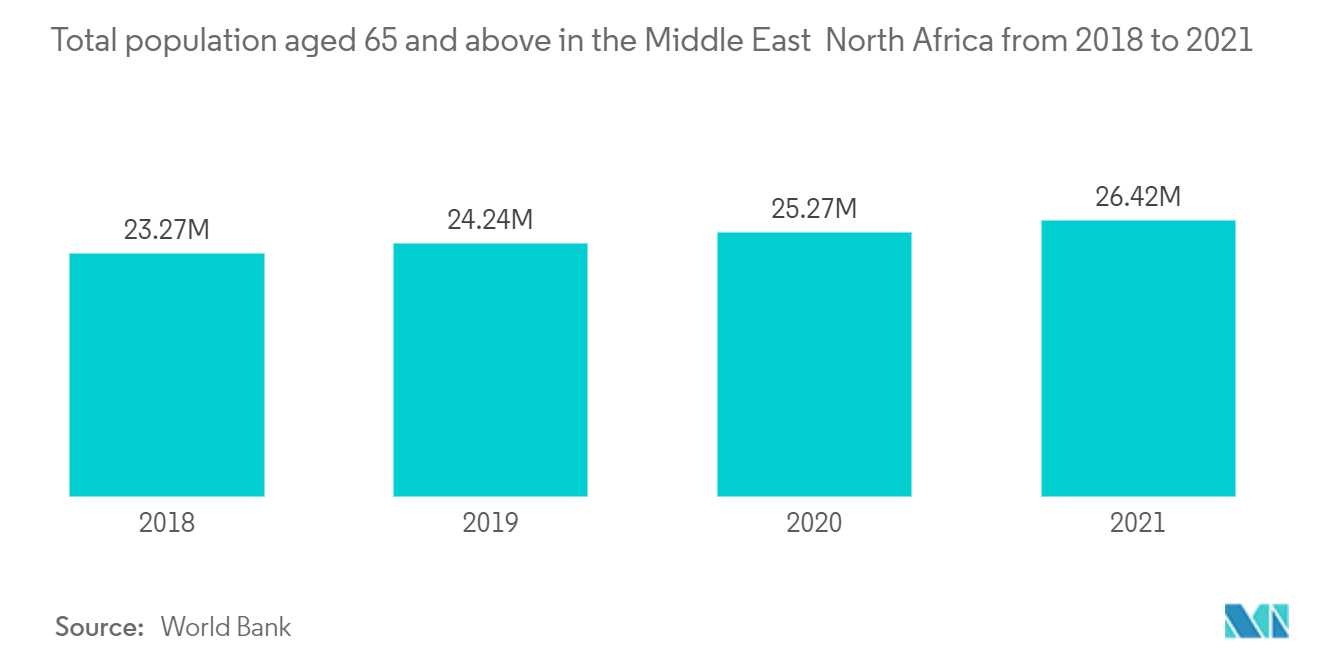
United Arab Emirates is Expected to Hold Major Share
- Fashion and functionality are among the significant aspects driving the smartwatch segment in the United Arab Emirates. Further, according to Samsung Gulf Electronics, the smartwatch is no longer only a smartwatch or tool; it is now a fashion that is part of consumers' daily life. Style and functionality are among the significant aspects of driving wearables in the United Arab Emirates.
- Consumers are increasingly looking out for sleek designs, trendy interfaces, and different types and colors of straps. The next wave of growth for the smartwatch market is expected to rise from the adoption by value-seeking consumers and from existing fitness band owners looking to enhance smartwatches now that they provide a better value proposition.
- In June of the current year, the HUAWEI WATCH D, a wrist-type ECG and blood pressure monitoring gadget, was introduced by Huawei Consumer Business Group in the UAE. HUAWEI WATCH D enables wrist-type ECG and blood pressure monitoring everywhere, bringing the convenience of health monitoring to consumers' wrists. At only 40.9g, HUAWEI WATCH D is lightweight. It offers several workout programs and features for keeping track of health. It also employs a small pump to take a reliable blood pressure reading at any time or location.
- Also, In September this year, Fitbit declared the launch of the next generation of Fitbit wearables combining Fitbit's health and wellness tools with the smarts of Google - Sense 2, Versa 4, and Inspire 3 in the UAE. Fitbit aimed to deliver products with improved batteries, even slimmer and more comfortable designs, and less daily charging requirements.
- As per Telecommunications Regulatory Authority (UAE), in the United Arab Emirates, there were approximately 3.68 million internet subscriptions as of earlier this year. Compared to December 2020, this number represents an increase of almost 700 000 subscriptions. This rise in overall internet subscriptions will positively influence the market, bringing enormous growth opportunities for the market to grow and expand throughout the forecast period.
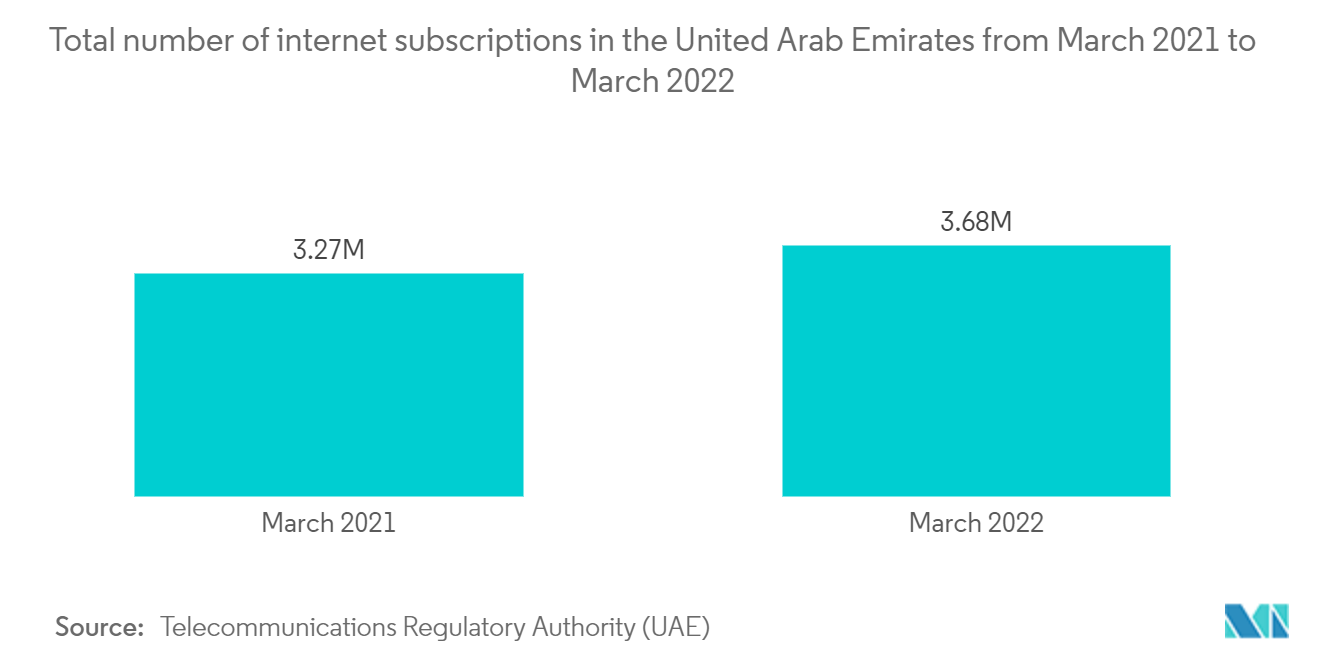
Competitive Landscape
The Middle East & Africa Smart Watch market is quite competitive. Various international brands keep launching new products, offering advanced technologies to gain a foothold in the region. However, in terms of market share, players such as Apple and Samsung occupy a significant portion, and players such as Huawei continue to disrupt the market share of Apple and Samsung in the region.
In October 2022 - IoT device maker CardoO, based in Egypt, raised $660,000 in a seed investment round led by The Alexandria Angels and included angel investors from Saudi Arabia named Sofico Investments and the European Bank for Reconstruction and Development. By enabling MENA customers to access the newest cheap consumer electronics and Internet of Things (IoT) gadgets, CardoO intends to establish itself as the leading Arab brand that offers people premium and cost-effective smart devices that improve their daily life.
In September 2022 - The release of the HUAWEI Band 7, HUAWEI WATCH GT 3 Pro in South African retail stores, and the HUAWEI online shop marks a turning point in the development of fitness and health wearable technology. The two smartwatches and fitness bands preserve the design and material quality of high-end luxury watches, have an extraordinarily long battery life and include a variety of advanced capabilities to assist users in learning new ways to lead active and healthy lifestyles.
Middle East and Africa Smartwatch Industry Leaders
-
Apple Inc.
-
Samsung Electronics Co. Ltd
-
Fitbit Inc. (Google, Inc.)
-
Huawei Technologies Co. Ltd
-
Sonly Middle East & Africa (Sony Corporation)
- *Disclaimer: Major Players sorted in no particular order
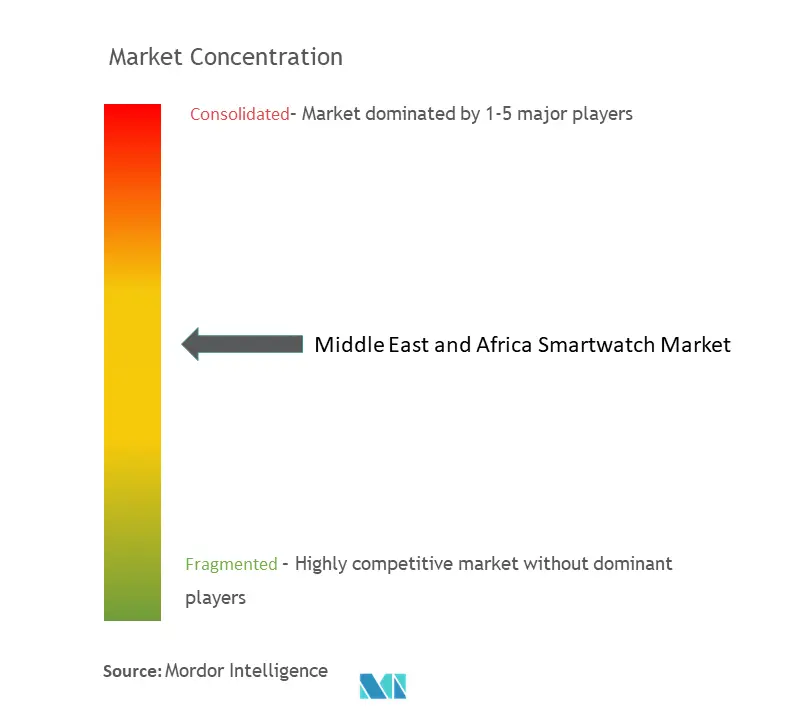
Recent Industry Developments
- November 2022 - With the assistance of Intertec Group, which serves as the country of Qatar's authorized distributor for Amzfit smart watches, Amazfit, a global brand of wearable technology owned by Zepp Health, has introduced the fourth generation of its GTR and GTS series in Qatar. The new watches have advanced sporting capabilities, huge HD AMOLED displays, and the industry's first circularly polarised GPS antenna technology, all housed in fashionable designs.
- October 2022 - Xiaomi introduced the Smart Band 7 Pro in the UAE. Through its larger viewing area and auto-brightness feature, the Xiaomi Smart Band 7 Pro improves every discriminating user's watching experience in a lot more practical and enjoyable way without sacrificing its beautiful details. It has a high-resolution 1.64" rectangular AMOLED screen. Xiaomi Smart Band 7 Pro features over 110 sports modes that may satisfy any user's tracking requirements, from sleep monitoring to sports tracking.
Middle East and Africa Smartwatch Market Report Scope
A smartwatch is a wearable electronic device with computed capabilities for specific functions and closely resembles a wristwatch. Owing to the type of application it is used for, and in addition to displaying the time, most smartwatches have wireless communication capabilities that a user can use from the watches interface to initiate and answer phone calls, read emails and messages, receive weather report updates, dictate emails or text messages, or use it as a personal digital assistant.
The Middle East & Africa Smartwatch market is segmented by Operating Systems (Watch OS, Android/Wear OS), Display Type (AMOLED, PMOLED, and TFT LCD), Application (Personal Assistance, Medical, Sports), and Country.
The market sizes and forecasts are provided in terms of value (USD billion) for all the above segments.
| Watch OS |
| Android/Wear OS |
| Other Operating Systems |
| AMOLED |
| PMOLED |
| TFT LCD |
| Personal Assistance |
| Medical |
| Sports |
| Other Applications |
| United Arab Emirates |
| Saudi Arabia |
| South Africa |
| Rest of Middle East & Africa |
| By Operating Systems | Watch OS |
| Android/Wear OS | |
| Other Operating Systems | |
| By Display Type | AMOLED |
| PMOLED | |
| TFT LCD | |
| By Application (Qualitative Analysis) | Personal Assistance |
| Medical | |
| Sports | |
| Other Applications | |
| By Country | United Arab Emirates |
| Saudi Arabia | |
| South Africa | |
| Rest of Middle East & Africa |
Key Questions Answered in the Report
How big is the Middle East and Africa Smartwatch Market?
The Middle East and Africa Smartwatch Market size is expected to reach USD 1.82 billion in 2025 and grow at a CAGR of 12.17% to reach USD 3.23 billion by 2030.
What is the current Middle East and Africa Smartwatch Market size?
In 2025, the Middle East and Africa Smartwatch Market size is expected to reach USD 1.82 billion.
Who are the key players in Middle East and Africa Smartwatch Market?
Apple Inc., Samsung Electronics Co. Ltd, Fitbit Inc. (Google, Inc.), Huawei Technologies Co. Ltd and Sonly Middle East & Africa (Sony Corporation) are the major companies operating in the Middle East and Africa Smartwatch Market.
What years does this Middle East and Africa Smartwatch Market cover, and what was the market size in 2024?
In 2024, the Middle East and Africa Smartwatch Market size was estimated at USD 1.60 billion. The report covers the Middle East and Africa Smartwatch Market historical market size for years: 2021, 2022, 2023 and 2024. The report also forecasts the Middle East and Africa Smartwatch Market size for years: 2025, 2026, 2027, 2028, 2029 and 2030.
Page last updated on:
Middle East and Africa Smartwatch Market Report
Statistics for the 2025 Middle East and Africa Smartwatch market share, size and revenue growth rate, created by Mordor Intelligence™ Industry Reports. Middle East and Africa Smartwatch analysis includes a market forecast outlook for 2025 to 2030 and historical overview. Get a sample of this industry analysis as a free report PDF download.
